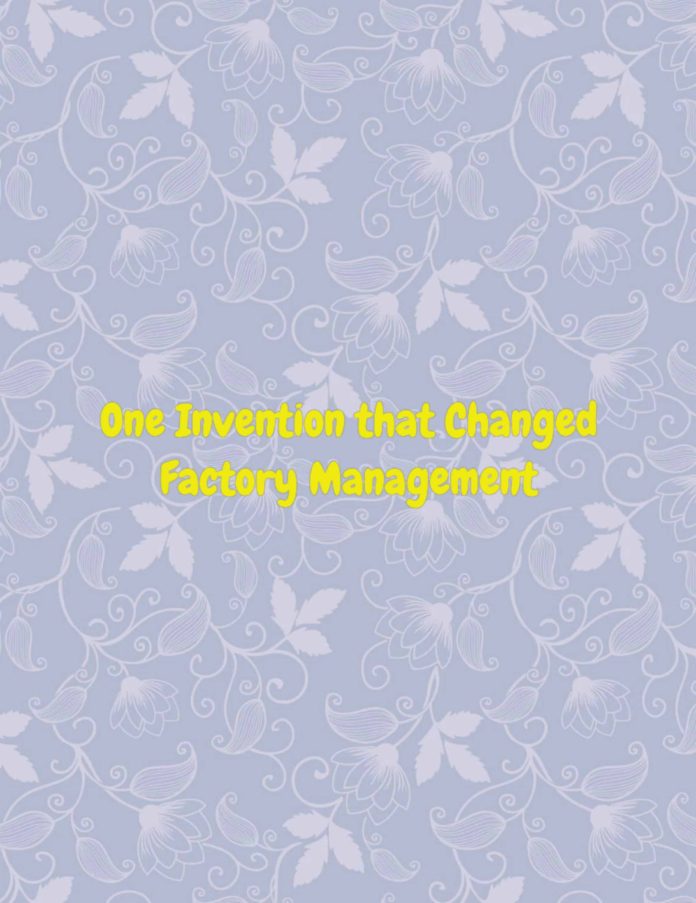The Industrial Revolution marked the beginning of the era of changes in the goods and services used by the people. As factories were set up and factory owners undertook production on larger scale, the need for understanding the new sector was felt to maximise profits and minimise costs. One way of achieving this objective was the belief that managing the factory units efficiently would result in utilising their ability to their maximum potential and hence help in reducing costs and increasing profits. A revolutionary change was brought in the way factories were managed by The Principles of Scientific Management, introduced by Fredric Winslow Taylor.
‘The Principles of Scientific Management’ was an article published by FW Taylor in ‘The American Magazine’ in the year 1911. These principles consist of guidelines for effective and efficient management of factory work. They are based on experiments conducted scientifically and aim at influencing the behaviour of people of the organisation. Hence, these principles recognise human resource as the most important asset in any organisation.
Fredric Winslow Taylor was an American mechanical engineer, born on 20th March 1856. He got a degree in mechanical engineering from Stevens Institute of Technology in the year 1883. He was a scientist by nature and believed that science could be applied to every aspect of an organisation to maximise its efficiency. Accordingly, he became devoted to developing science based principles for improving the working of factory setup.
Principles of Scientific Management
Science, Not Rule of Thumb
At the early stages of Industrial Revolution, there was no set method of production and so, different factory owners came up with different methods which were based on trial and error approach. This led to wastage of time and resources or did not provide the best route for undertaking a task. Taylor believed that there is only one best method of doing things. This method should be based on the traditional practices and science and should be perfected through experimentation, but once perfected, it should be followed throughout the organisation and replace the rule of thumb approach.
Harmony, Not Discord
Managers got things done by the workers and hence acted as a link between the owners and the workforce. Hence, there always existed a conflict between the interests of managers and workers, as managers wanted the work to be done better at minimum wages while workers wanted to work for more wages. Taylor believed that this kind of conflict would not benefit the organisation. Hence, it would be in their best interest to work with harmony and respect each other. Management should ensure adequate wages to workers while workers should desist from making unnecessary demands from the management.
Cooperation, Not Individualism
The decisions taken by the management affect all the members of the organisation. Hence, Taylor believed that workers should not be discouraged for their suggestions and feedback. Instead, management should listen to the ideas of the workers as it may prove beneficial for the organisation. Workers should be rewarded for their innovative ideas and initiative.
Development of Every Individual to His/Her Greatest Prosperity
Taylor believed that every person associated with the organisation would perform his/her best if positive steps are taken to train and develop them. Hence, each person should be trained and guided to do the work at his/her best potential. Work should be assigned in consideration of the competencies and capabilities of the workers.
Techniques of Scientific Management
Functional Foremanship
A supervisor or a foreman is a manager who supervises the workers in a factory. Since this managerial figure is in direct contact with the workforce, Taylor believed that this was the most important part of the organisation for achieving operational efficiency. He worked out certain skills and qualities of good supervisors and found that no single person could have all those qualities. Accordingly, he divided the work into eight foremen as follows:
Instruction card clerk– to draft instructions to be followed by workers
Route Clerk– to specify route of production to workers
Time and Cost Clerk– to prepare time and cost sheet
Disciplinarian– to ensure discipline and order
Speed Boss– to ensure timely completion of work
Gang Boss– looking after the machinery and tools and keeping them ready
Repair Boss– repairing any damages
Inspector– to check the quality of output
Standardisation and Division of Work
Standardisation refers to ensuring a certain minimum standard of work and division of work refers to distribution of jobs among people. Taylor believed that work should be done keeping in mind a certain minimum standard of quality and work should be divided among people according to their skill and capabilities.
Method Study
This involved critical evaluation of the way in which work was done to determine the practices which were actually beneficial and activities which were superfluous. All the unnecessary activities should be discarded and the useful activities should be integrated to develop the One Best Method of doing the work.
Motion Study
Motion refers to the movements in production process. This technique involves developing the shortest route for completing production. Under this, unnecessary motions should be discarded.
Time Study
This study involved measuring the time taken for completion of work. This would help to determine whether work was being done according to the Best Method or not.
Fatigue Study
People tend to experience exhaustion after working for a certain amount of time. Accordingly, this study is used to determine the amount and frequency of breaks required for completion of a particular job.
Differential Piece Wage System
This method uses wage as a financial incentive to boost the productivity of the workers. A standard is set and all workers who perform equal to or above the standard level were to be paid more wages than the workers performing below the standard. The difference between the wages of productive and less productive workers would act as an incentive for the less productive workers to work harder and would ultimately boost productivity.
The contributions of FW Taylor helped to improve factory productivity immensely and the principles established by him still find an important role in the way things are managed in factories even today.
By Pranav Garg










Good literature by pranav.
Techniques of scientific management is elaborated well and requirements of today’s competitive world.
💯👍
I couldn’t resist commenting
Do you have a spam problem on this website; I also am a blogger, and I was wondering your situation; we have developed some nice methods and we are looking to swap strategies with other folks, be sure to shoot me an email if interested.
Would you be enthusiastic about exchanging links?
After all, what a great site and informative posts, I will upload inbound link – bookmark this web site? Regards, Reader.
Thank you for sharing excellent informations. Your site is so cool. I’m impressed by the details that you’ve on this web site. It reveals how nicely you perceive this subject. Bookmarked this website page, will come back for extra articles. You, my friend, ROCK! I found just the information I already searched everywhere and simply could not come across. What an ideal web-site.